We rescue baby animals regularly, both birds and mammals, which we then hand-raise ourselves. Occasionally we also have to raise youngsters born at PTWRC which the mothers are neglecting. In my early days at PTWRC all new arrivals were taken to Quarantine, which was a disgrace when I arrived and which I have renewed several times and repaired more frequently. It could still be better, but one must remember that, unlike most zoos, we have to deal with new arrivals on a daily basis, sometimes hundreds of animals each month, and our Quarantine must cope with this. I used to pay keepers extra money to look after infants that had lost their mothers. Anything I considered delicate I raised myself, such as tiger cub,
Areang. Perhaps encouraged by the extra dollars the quarantine keepers, Tan and Soupheap, did an excellent job. I still remember Mr Tan walking around Phnom Tamao with as many as three or four baby macaques clinging to his shirt. At the end of the day he would place them all in the basket on the front of his bicycle and ride home with them. Soupheap raised Dwain Freakly, the deranged gibbon we rescued from the forecourt of a petrol station in 2002 – an appropriate choice of surrogate mother if ever there was one!
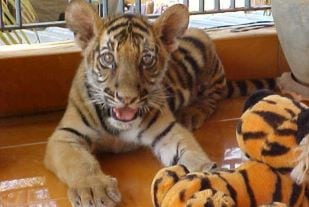
Tiger cub, Areang
We did well enough, but Quarantine was not the place to raise delicate youngsters and with a little help from our friends we created what is now our Baby Nursery in the Rehab Area of PTWRC, which is not open to the visiting public. We do not have the funds for fancy equipment, but make do with the basic essentials. We created a bedroom for keepers administering the night care and another in which to keep the young animals during the hours of darkness. We have also built an assortment of cages behind the Nursery into which we can transition the orphans as they grow.
In the early days Pisey and Doo were the young keepers who worked in the new Nursery. Beer and girls came into their lives and unfortunately we had to part with Mr Doo. Pisey is still with us, he is now married and works alongside Ran and Par. He is caring, with a wisdom brought on by experience that belies his lack of years. I was told Mr
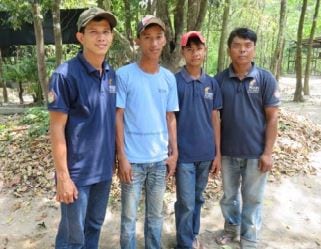
Vet Chenda with Pisey, Par and Ran
Par was 18 years old when he started with us, but he looked only 14. He is as gentle as he looks and the young animals all love him. Mr Ran is a little older and has introduced a sense of greater responsibility to the work. They all do an excellent job, particularly when one considers the conditions in which we have to raise our baby animals at PTWRC – no clean running water and until
last year no electricity. Work is around the clock, with feeds every two or three hours and the guys take it in turns to do the night shift.
Beginning in March, there is always an influx of fledgling birds of all species – eagles, owls, mynahs, parakeets, rollers, barbets and many more. We often release these from enclosures at the Nursery when they are old enough and continue to provide food for them as they find their way in the world.
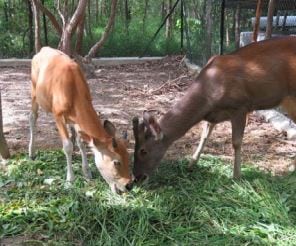
“…recovered from his wounds…”
We have had our sad and unexplained losses since we created the Nursery. Often infants arrive in a very weak condition and we know from the start that survival is unlikely. Until recently we had great difficulty raising langurs and several silvered and douc langurs died. I discovered we could buy goats’ milk in Cambodia and with the addition of soya based infant formula and some extra protein they are faring better nowadays.
But it is not all bad news. We have also cared for babies that were sure to die where somehow we managed to over-turn the odds. The young male sambar we took to WRS in March is one of these. He and his mother were mauled by domestic dogs that plague the Phnom Tamao forest. The female was bitten and ran off leaving her small fawn with serious bite wounds and a broken hind leg. We managed to rescue him. He was extremely weak, but with gentle care he recovered from his wounds and the fracture healed. On March 21st we took him down to start a new life in the forests of the Southern Cardamoms and we will release him and his partner when the time comes.
Two other stories demonstrate the care and dedication of our young Nursery keepers. Yellow-cheeked gibbon, Iggy, short for Ignatius, arrived from Ratanakiri tiny, frail and weak. He had a rash of fine white blotches all over his body, perhaps a fungal infection. His lack-lustre eyes told us he was not at all well. Time passed and the night and day milk feeds gradually became supplemented with solid foods. As he grew stronger he took over the milk feeds himself, no longer requiring the keepers’ assistance to hold the bottle. He transitioned to a larger enclosure within the Nursery and slowly the milk feeds stopped altogether. His color has now changed from golden to adult black and he shares a large enclosure with
Mom-mom, our only female yellow-cheeked gibbon. He is now a mad bundle of energy and a far cry from his early days of disease and malnutrition.
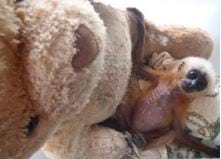
Ignatius on arrival
Perhaps even more surprising is the story of Lil Monster, the orphaned pig-tailed macaque. He was born at Phnom Tamao and shortly after his birth his father brutally attacked him, biting his leg, arm and head, damaging his ear and putting out his left eye. The head wounds were very serious. He had neurological damage and was paralysed down his left side, unable to move his left arm and leg. The little chap cried
constantly with the pain. Our vets gave him daily medication and Ran, Pisey and Par, with great difficulty, managed to get him to take a little milk every two hours.
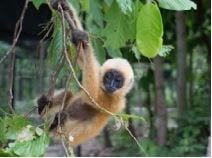
“…mad bundle of energy.”
As we do with all our infant primates, we gave him a teddy bear for comfort. This surely helps, but the tiny macaque was clearly in such distress that I asked Mr Ran if he thought it might be kinder to the monkey and also easier on himself and his colleagues if we gently euthanized him. Ran replied, asking me to give him a little longer and a chance to pull through. The subject never came up again, although Ran still reminds me of my words sometimes. The cries of pain gradually lessened, the monkey began putting on weight and he slowly regained a little use of his injured arm and leg.
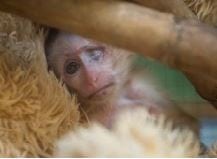
“Head wounds were serious”
This was over two years ago. Our pig-tail is now sharing a small enclosure in the Nursery Area with another young male pig-tailed macaque we rescued. He is around half the size he should be for his age, still carries his head on one side and is without his left eye. Lil Monster is certainly no oil painting, but he has full use of his arms and legs now and behaves just like any other young macaque. He is not bothered what he looks
like, he is a happy monkey and very glad to be alive!
Many rescue centres do not take macaques.
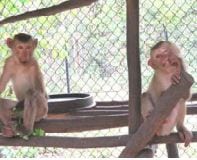
“Happy to be alive”
They arrive so frequently and take up considerable resources, which could usefully be spent elsewhere. At Phnom Tamao we feel it is our duty to give everything a chance…. although I am not sure what we will do with yet another adult male pig-tailed macaque we cannot release. Never mind! We will sort that problem when we get to it. I am sure there are some will ask if the care we take over Lil Monster and his colleagues is worth all the trouble. You do not need me to tell you what Mr Ran’s reply will be….

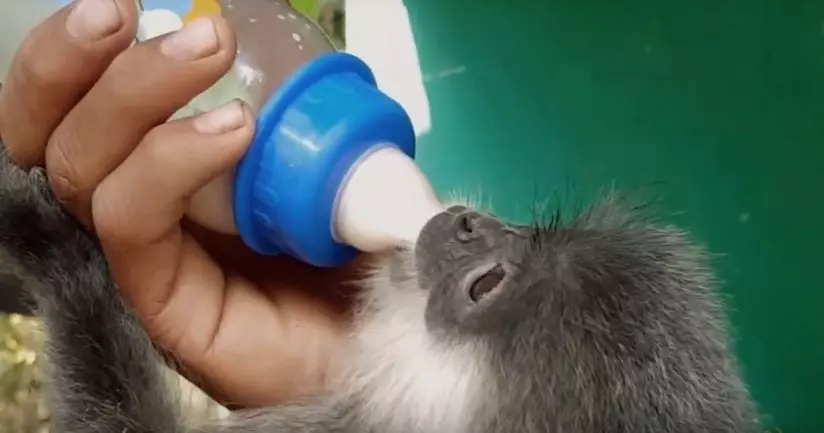

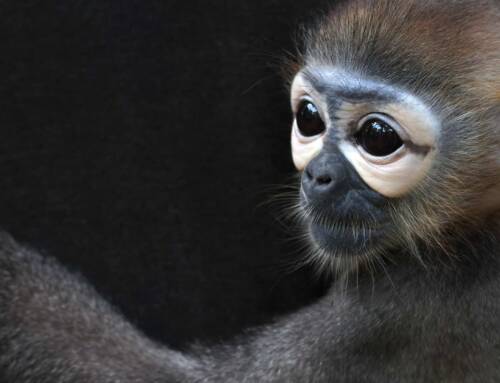
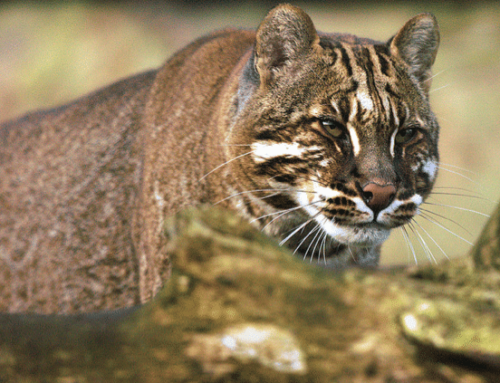
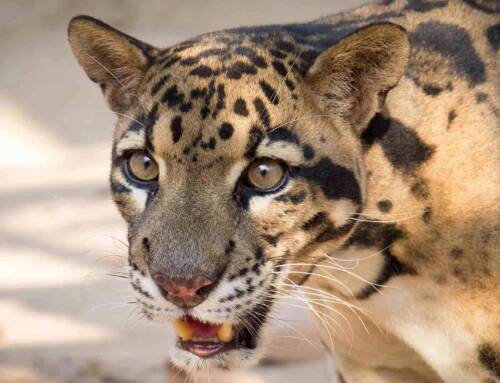
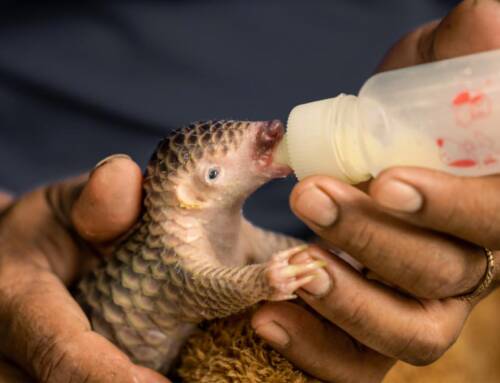
Dɑddy wins!? Тhe tᴡins declared.